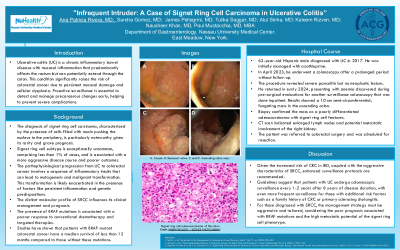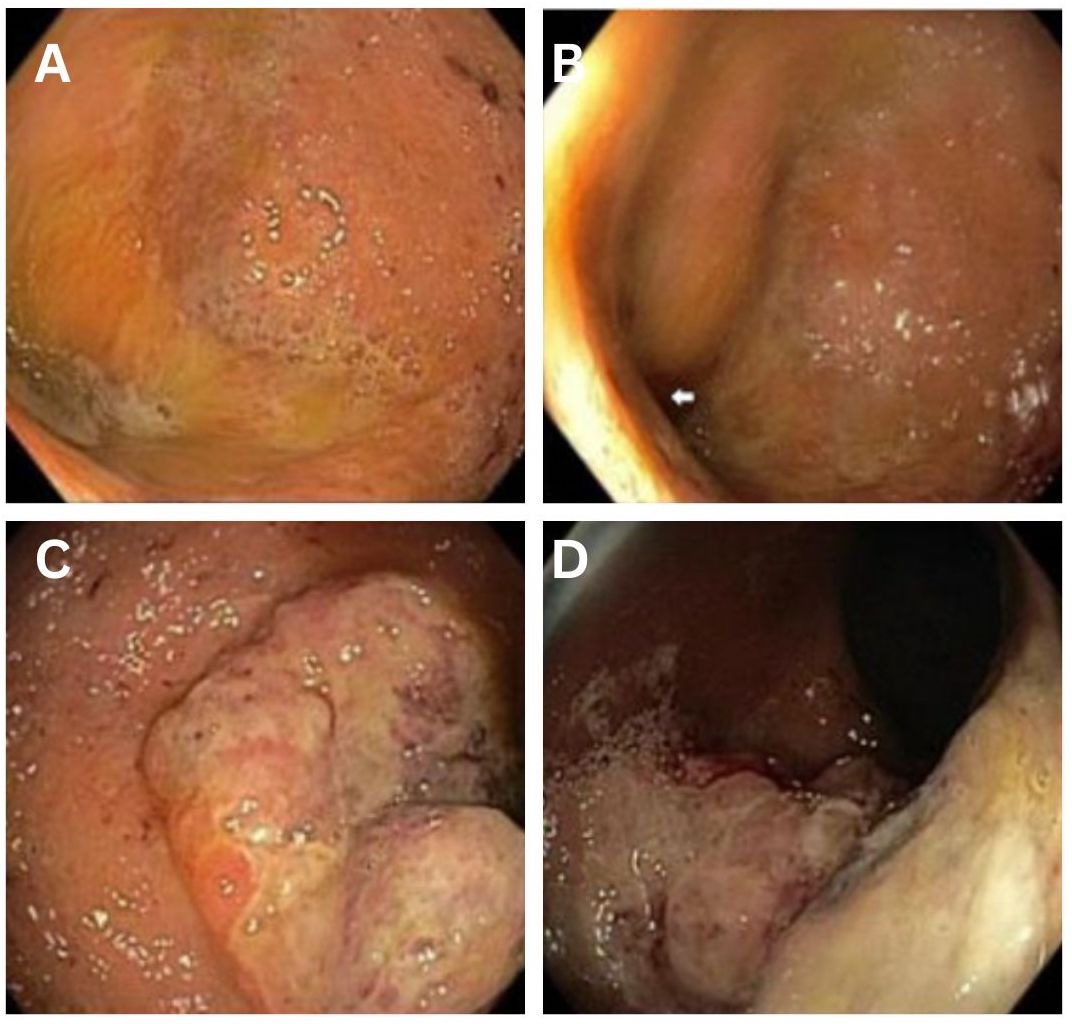Monday Poster Session
Category: Colorectal Cancer Prevention
P2167 - Infrequent Intruder: A Case of Signet Ring Cell Carcinoma in Ulcerative Colitis
Monday, October 28, 2024
10:30 AM - 4:00 PM ET
Location: Exhibit Hall E

Has Audio

Ana P. Rivera Arauz, MD
Nassau University Medical Center
Amityville, NY
Presenting Author(s)
Ana P. Rivera, MD1, Sandra Gomez, MD2, James R. Pellegrini, MD3, Tulika Saggar, MD2, Atul Sinha, MD2, Kaleem Rizvon, MD, FACG2, Nausheer Khan, MD2, Paul Mustacchia, MD, MBA2
1Nassau University Medical Center, Amityville, NY; 2Nassau University Medical Center, East Meadow, NY; 3Nassau University Medical Center, Great River, NY
Introduction: Ulcerative colitis (UC) is a chronic inflammatory bowel disease with mucosal inflammation that predominantly affects the rectum but can potentially extend through the colon. This condition significantly raises the risk of colorectal cancer due to persistent mucosal damage and cellular dysplasia. Proactive surveillance is essential to detect and manage precancerous changes early, helping to prevent severe complications.
Case Description/Methods: We present the case of a 62-year-old Hispanic male diagnosed with UC in 2017. Initially managed with azathioprine, his treatment journey was complicated by medication non-adherence due to insurance issues, leading to poor disease control. In April 2023, after a prolonged period without follow-up, he underwent a colonoscopy that showed severe pancolitis but no neoplastic lesions. The patient returned in early 2024 for another surveillance colonoscopy. His pre-surgical tests revealed low hemoglobin levels. The procedure was done as inpatient and unveiled a 10 cm semi-circumferential, fungating mass in the ascending colon. Biopsy confirmed the mass as a poorly differentiated adenocarcinoma with signet ring cell features. A CT scan indicated enlarged lymph nodes and potential metastatic involvement of the right kidney. The patient was referred to colorectal surgery and was scheduled for resection.
Discussion: The diagnosis of signet ring cell carcinoma, characterized by the presence of cells filled with mucin pushing the nucleus to the periphery, is particularly noteworthy given its rarity and grave prognosis. In colorectal cancer, signet ring cell subtype is exceptionally uncommon, comprising less than 1% of cases, and is associated with a more aggressive disease course and poorer outcomes. The pathophysiological progression from UC to colorectal cancer involves a sequence of inflammatory insults that can lead to mutagenesis and malignant transformation. This transformation is likely exacerbated in the presence of factors like persistent inflammation and genetic predispositions. The molecular characteristics of signet ring cell carcinoma include a less frequent occurrence of KRAS and NRAS mutations, a more common presence of BRAF and CIMP mutations, as well as diminished expression levels of p16 and p53. The aggressive nature and atypical presentation of signet ring cell carcinoma in the colon highlight the importance of maintaining stringent surveillance and management protocols in patients with chronic UC to detect such malignancies at an earlier stage.

Disclosures:
Ana P. Rivera, MD1, Sandra Gomez, MD2, James R. Pellegrini, MD3, Tulika Saggar, MD2, Atul Sinha, MD2, Kaleem Rizvon, MD, FACG2, Nausheer Khan, MD2, Paul Mustacchia, MD, MBA2. P2167 - Infrequent Intruder: A Case of Signet Ring Cell Carcinoma in Ulcerative Colitis, ACG 2024 Annual Scientific Meeting Abstracts. Philadelphia, PA: American College of Gastroenterology.
1Nassau University Medical Center, Amityville, NY; 2Nassau University Medical Center, East Meadow, NY; 3Nassau University Medical Center, Great River, NY
Introduction: Ulcerative colitis (UC) is a chronic inflammatory bowel disease with mucosal inflammation that predominantly affects the rectum but can potentially extend through the colon. This condition significantly raises the risk of colorectal cancer due to persistent mucosal damage and cellular dysplasia. Proactive surveillance is essential to detect and manage precancerous changes early, helping to prevent severe complications.
Case Description/Methods: We present the case of a 62-year-old Hispanic male diagnosed with UC in 2017. Initially managed with azathioprine, his treatment journey was complicated by medication non-adherence due to insurance issues, leading to poor disease control. In April 2023, after a prolonged period without follow-up, he underwent a colonoscopy that showed severe pancolitis but no neoplastic lesions. The patient returned in early 2024 for another surveillance colonoscopy. His pre-surgical tests revealed low hemoglobin levels. The procedure was done as inpatient and unveiled a 10 cm semi-circumferential, fungating mass in the ascending colon. Biopsy confirmed the mass as a poorly differentiated adenocarcinoma with signet ring cell features. A CT scan indicated enlarged lymph nodes and potential metastatic involvement of the right kidney. The patient was referred to colorectal surgery and was scheduled for resection.
Discussion: The diagnosis of signet ring cell carcinoma, characterized by the presence of cells filled with mucin pushing the nucleus to the periphery, is particularly noteworthy given its rarity and grave prognosis. In colorectal cancer, signet ring cell subtype is exceptionally uncommon, comprising less than 1% of cases, and is associated with a more aggressive disease course and poorer outcomes. The pathophysiological progression from UC to colorectal cancer involves a sequence of inflammatory insults that can lead to mutagenesis and malignant transformation. This transformation is likely exacerbated in the presence of factors like persistent inflammation and genetic predispositions. The molecular characteristics of signet ring cell carcinoma include a less frequent occurrence of KRAS and NRAS mutations, a more common presence of BRAF and CIMP mutations, as well as diminished expression levels of p16 and p53. The aggressive nature and atypical presentation of signet ring cell carcinoma in the colon highlight the importance of maintaining stringent surveillance and management protocols in patients with chronic UC to detect such malignancies at an earlier stage.

Figure: Figure 1. A. Cecum with boggy, erythematous, friable mucosa with areas of patchy ulceration and significant exudate noted. B. Stenotic ileocecal valve. C and D. Ascending colon mass measuring approximately 10 cm, laterally spreading, fungating, semi-circumferential, friable.
Disclosures:
Ana Rivera indicated no relevant financial relationships.
Sandra Gomez indicated no relevant financial relationships.
James Pellegrini indicated no relevant financial relationships.
Tulika Saggar indicated no relevant financial relationships.
Atul Sinha indicated no relevant financial relationships.
Kaleem Rizvon indicated no relevant financial relationships.
Nausheer Khan indicated no relevant financial relationships.
Paul Mustacchia indicated no relevant financial relationships.
Ana P. Rivera, MD1, Sandra Gomez, MD2, James R. Pellegrini, MD3, Tulika Saggar, MD2, Atul Sinha, MD2, Kaleem Rizvon, MD, FACG2, Nausheer Khan, MD2, Paul Mustacchia, MD, MBA2. P2167 - Infrequent Intruder: A Case of Signet Ring Cell Carcinoma in Ulcerative Colitis, ACG 2024 Annual Scientific Meeting Abstracts. Philadelphia, PA: American College of Gastroenterology.
